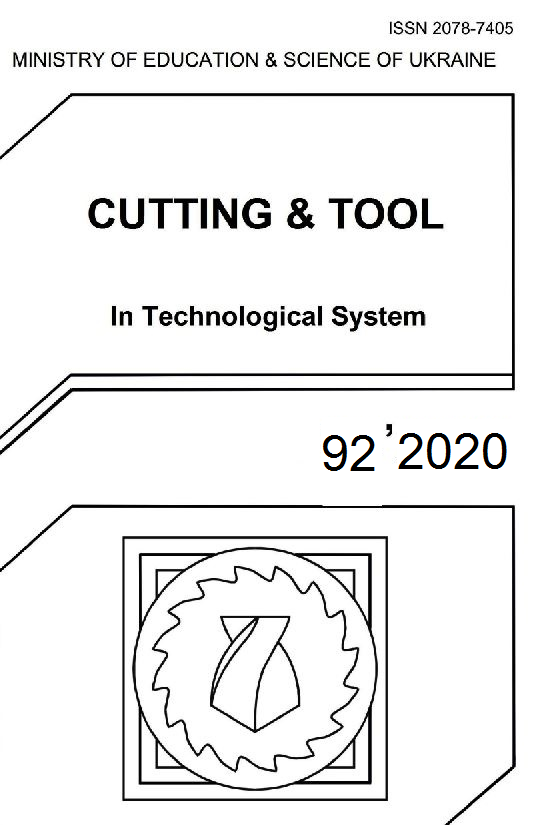THE PECULIARITIES OF SETTING THE GRINDING COEFFICIENT IN THE PROCESSING OF POLYCRYSTALLINE SUPERHARD MATERIALS
DOI:
https://doi.org/10.20998/2078-7405.2020.92.18Keywords:
polycrystalline superhard materials, diamond circle, cutting circle relief, working surface of a circle, bonding of the circle, self-sharpening of a circle, the cutting force, the effective component of the cutting force, the frequency of the grinding process.Abstract
The questions related to the peculiarities of determining such a physical characteristic of the process of grinding polycrystalline superhard materials by diamond circles on metal and organic bonds as a coefficient of grinding are considered. It is the ratio of the tangential and normal components of the cutting force when grinding. It is proposed to determine it using the effective component of the tangential component of the cutting force. Its establishment is based on the use of the phenomenon of adaptation of the grinding process in general and its individual component, the periodicity of change in time of physical and technological indicators of processing in particular. The physical nature of the occurrence of the periodicity with respect to the conditions of the controlled grinding process according to the elastic scheme and to the conditions of the process of grinding polycrystalline superhard materials diamond circles on organic bonds in the self-sharpening mode is disclosed. It was established that when using the first process as a factor of forced influence on the state of the cutting surface of a circle it is necessary to choose the magnitude of intensity of electrophysical solution of the metal ligament of the diamond circle, and in the second transverse supply to the depth of processing. Recommendations regarding the choice of factors of forced influence are given. It is shown, that the peculiarity of the elastic treatment scheme is that the normal component of the cutting force is constant in time. Therefore, the change (increase or decrease) of the effective component of the tangential component of the grinding force leads to similar changes in the grinding coefficient and can clearly judge the effectiveness of the method or conditions of grinding that explores. In contrast to the elastic circuit grinding when working on a rigid scheme, both components (tangential and normal) grinding force, which are used to define the grinding coefficient, depend on the processing conditions. This fact should be considered when analyzing the obtained experimental data. In the future, research results will help to improve the grinding processes of polycrystalline superhard materials.References
: 1. Epifanov V.I. Tehnologiya obrabotki almazov v brilliantyi / Epifanov V.I., Pesina A.Ya., Zyikov L.V. - M.: Vyissh. shk., 1984. - 319 p.
Semko M. F. Almaznoe shlifovanie sinteticheskih sverhtverdyih materialov / M. F. Semko, A. I. Grabchenko, M. G. Hodorevskiy. -Kharkiv: Vischa shkola, 1980. - 192 p.
Grabchenko A.I. Povyishenie proizvoditelnosti shlifovaniya PNTM s upravleniem rezhuschim relefom kruga / Grabchenko A.I., Pyzhov I.N // Sverhtverdyie materialyi. – 1982. – # 5. – pp. 34-37.
Pyzhov I. N. Osobennosti samozatachivaniya almaznyih krugov na organicheskih svyazkah pri shlifovanii PNTM / I. N. Pyzhov // Rezanie i instrument v tehnologicheskih sistemah: Mezhdunar. nauch.-tehn. sb.–Kharkiv: 2018. – Vyip.88. – pp. 179-192.
Pyzhov I. N. Silovyie harakteristiki protsessa shlifovaniya PNTM v rezhime samozatachivaniya almaznyih krugov / I. N. Pyzhov, V.A. Fedorovich, I.V. Voloshkina // Rezanie i instrument v tehnologicheskih sistemah: Mezhdunar. nauch.-tehn. sb. – Kharkiv: 2018. – Vyip. 88. – pp. 193-203.
Uzunyan M.D. Shlifovanie nanostrukturnyih tverdyih splavov: ucheb. posobie dlya studentov mashinostroitelnyih spetsialnostey dnevnoy i zaochnoy form obucheniya / M.D. Uzunyan, R.M. Strelchuk. – Kharkiv: NTU «KhPI», 2015. – 182 p.
Pat. 141335 Ukraine, MPK (2020.01) B24V 1/00. SposIb otsInyuvannya efektivnostI protsesu shlIfuvannya polikristalichnih nadtverdih materialiv / Pizhov I.M. (UA); Fedorovich V. O. (UA); VoloshkIna I. V. (UA). Vlasnik Natsionalniy tehnichniy universitet «Kharkivskiy politehnichniy Institut». - # u 2019 07269; zayavl. 01.07.2019; opubl. 10.04.2020, byul. # 7.
Pat. 72861 Ukraine, MPK (2012.01) V24 V 1/00. Sposib viznachennya efektivnoyi skladovoyi tangentsialnoyi sili rizannya/ Alekseenko D.M. (UA), Grabchenko A.I. (UA), Pizhov I.M. (UA). Vlasnik Sumskiy derzhavniy universitet. -# u 2012 03280; zayavl. 29.12.2011; opubl. 27.08.2012. Byul. # 16.
Pat. 128946 Ukraine, MPK (2006) B24V 1/00. Sposib viznachennya efektivnoyi skladovoyi tangentsialnoyi sili rizannya / Pizhov I.M. (UA), Fedorovich V.O. (UA), VoloshkIna I. V. (UA). Vlasnik Natsionalniy tehnichniy universitet «Kharkivskiy politehnichniy Institut». - # u 2018 05053; zayavl. 07.05.2018 opubl. 10.10.2018, byul. # 19.
Downloads
Published
Issue
Section
License
Copyright Notice
Authors who publish with this Collection agree to the following terms:
1. Authors retain copyright and grant the Collection right of first publication with the work simultaneously licensed under a Creative Commons Attribution License that allows others to share the work with an acknowledgement of the work's authorship and initial publication in this Collection.
2. Authors are able to enter into separate, additional contractual arrangements for the non-exclusive distribution of the Collection's published version of the work (e.g., post it to an institutional repository or publish it in a book), with an acknowledgement of its initial publication in this Collection.
3. Authors are permitted and encouraged to post their work online (e.g., in institutional repositories or on their website) prior to and during the submission process, as it can lead to productive exchanges, as well as earlier and greater citation of published work.

